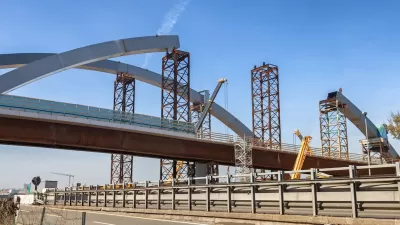The New York Times pays tribute to an American inventor, builder, and feminist who, more than anything, hated housework.
In the '70s and '80s, a quirky woman in a small Oregon town built a machine designed to free women from the drudgery of that tedious, all-consuming, yet unpaid labor: housework.
Frances Gabe died in January at the age of 101, leaving behind an automated, self-cleaning home that comprised more than 68 patented inventions. The New York Times recently remembered her in an obituary that lovingly details her achievements, eccentricities, and motivations.
The confinement of middle-class white women to the domestic sphere was fuel for the American movement now known as second-wave feminism—and for Gabe, it was at least in part a design problem. "You can talk all you like about women's liberation, but houses are still designed so women have to spend half their time on their knees or hanging their head in a hole," Gabe once said.
The self-cleaning house took decades of planning and at least 10 years to build by hand. Multiple videos have been made to show how it worked. Here's Margalit Fox's description from the Times:
In each room, Ms. Gabe, tucked safely under an umbrella, could press a button that activated a sprinkler in the ceiling. The first spray sent a mist of sudsy water over walls and floor. A second spray rinsed everything. Jets of warm air blew it all dry. The full cycle took less than an hour.
Runoff escaped through drains in Ms. Gabe’s almost imperceptibly sloping floors. It was channeled outside and straight through her doghouse, where the dog was washed in the bargain. …
Her sink, toilet and bathtub were also self-cleaning.
The Times also offers a glimpse into some of Gabe's designs, as well as previous coverage.
FULL STORY: Frances Gabe, Creator of the Only Self-Cleaning Home, Dies at 101

Planetizen Federal Action Tracker
A weekly monitor of how Trump’s orders and actions are impacting planners and planning in America.

Congressman Proposes Bill to Rename DC Metro “Trump Train”
The Make Autorail Great Again Act would withhold federal funding to the system until the Washington Metropolitan Area Transit Authority (WMATA), rebrands as the Washington Metropolitan Authority for Greater Access (WMAGA).

DARTSpace Platform Streamlines Dallas TOD Application Process
The Dallas transit agency hopes a shorter permitting timeline will boost transit-oriented development around rail stations.

Renters Now Outnumber Homeowners in Over 200 US Suburbs
High housing costs in city centers and the new-found flexibility offered by remote work are pushing more renters to suburban areas.

The Tiny, Adorable $7,000 Car Turning Japan Onto EVs
The single seat Mibot charges from a regular plug as quickly as an iPad, and is about half the price of an average EV.

Supreme Court Ruling in Pipeline Case Guts Federal Environmental Law
The decision limits the scope of a federal law that mandates extensive environmental impact reviews of energy, infrastructure, and transportation projects.
Urban Design for Planners 1: Software Tools
This six-course series explores essential urban design concepts using open source software and equips planners with the tools they need to participate fully in the urban design process.
Planning for Universal Design
Learn the tools for implementing Universal Design in planning regulations.
Municipality of Princeton
Roanoke Valley-Alleghany Regional Commission
City of Mt Shasta
City of Camden Redevelopment Agency
City of Astoria
Transportation Research & Education Center (TREC) at Portland State University
US High Speed Rail Association
City of Camden Redevelopment Agency
Municipality of Princeton (NJ)





























